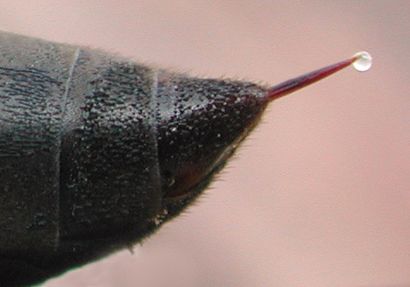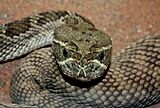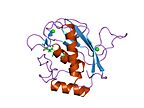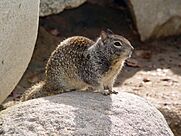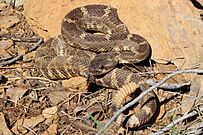Venom facts for kids
Venom or zootoxin is a type of toxin produced by an animal that is actively delivered through a wound by means of a bite, sting, or similar action. The toxin is delivered through a specially evolved venom apparatus, such as fangs or a stinger, in a process called envenomation.
Venomous species
Venom has evolved in terrestrial and marine environments and in a wide variety of animals.
- Venomous arthropods include spiders,centipedes, scorpions, bees and wasps.
- There are venomous invertebrates, including jellyfish such as the dangerous box jellyfish, the Portuguese man-of-war (a siphonophore). Some sea anemones, sea urchins, cone snailsand octopuses are venomous too.
- Venom is found in some 200 cartilaginous fishes, including stingrays, sharks, and chimaeras.
- Some 450 species of snake are venomous. Snake venom is produced by glands below the eye (the mandibular glands) and delivered to the target through tubular or channeled fangs.
- Venom is found in a few other reptiles such as the Mexican beaded lizard, the gila monster, and some monitor lizards, including the Komodo dragon.
- A few species of living mammals are venomous, including solenodons, shrews, vampire bats, male platypuses, and slow lorises.
Mechanisms
Venoms kill through the action of at least four major classes of toxin:
- necrotoxins and cytotoxins, which kill cells;
- neurotoxins, which affect nervous systems;
- myotoxins, which damage muscles;
- and haemotoxins, which disrupt blood clotting.
Venom and humans
Venomous animals cause tens of thousands of human deaths per year. Envenomation resulted in 57,000 human deaths in 2013, down from 76,000 deaths in 1990. Venoms, found in over 173,000 species, have potential to treat a wide range of diseases, explored in over 5,000 scientific papers.
In medicine, snake venom proteins are used to treat conditions including thrombosis, arthritis, and some cancers. Gila monster venom contains exenatide, used to treat type 2 diabetes. Solenopsins extracted from fire ant venom has demonstrated biomedical applications, ranging from cancer treatment to psoriasis. A branch of science, venomics, has been established to study the proteins associated with venom and how individual components of venom can be used for pharmaceutical means.
Resistance
Venom is used as a trophic weapon by many predator species. However, prey has developed resistance to certain venoms.
The California ground squirrel has varying degrees of resistance to the venom of the Northern Pacific rattlesnake. The resistance involves toxin scavenging and depends on the population. Where rattlesnake populations are denser, squirrel resistance is higher. Rattlesnakes have responded locally by increasing the effectiveness of their venom.
The kingsnakes of the Americas are constrictors that prey on many venomous snakes. They have evolved resistance which does not vary with age or exposure. They are immune to the venom of snakes in their immediate environment, like copperheads, cottonmouths, and North American rattlesnakes, but not to the venom of, for example, king cobras or black mambas.
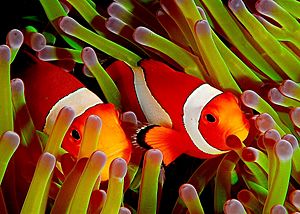
Among marine animals, eels are resistant to sea snake venoms, which contain complex mixtures of neurotoxins, myotoxins, and nephrotoxins, varying according to species. Eels are especially resistant to the venom of sea snakes that specialise in feeding on them, implying coevolution; non-prey fishes have little resistance to sea snake venom.
Clownfish always live among the tentacles of venomous sea anemones (an obligatory symbiosis for the fish), and are resistant to their venom. Only 10 known species of anemones are hosts to clownfish and only certain pairs of anemones and clownfish are compatible. All sea anemones produce venoms delivered through discharging nematocysts and mucous secretions. The toxins are composed of peptides and proteins. They are used to acquire prey and to deter predators by causing pain, loss of muscular coordination, and tissue damage. Clownfish have a protective mucus that acts as a chemical camouflage or macromolecular mimicry preventing "not self" recognition by the sea anemone and nematocyst discharge. Clownfish may acclimate their mucus to resemble that of a specific species of sea anemone.
See also
 In Spanish: Venenos animales para niños
In Spanish: Venenos animales para niños


